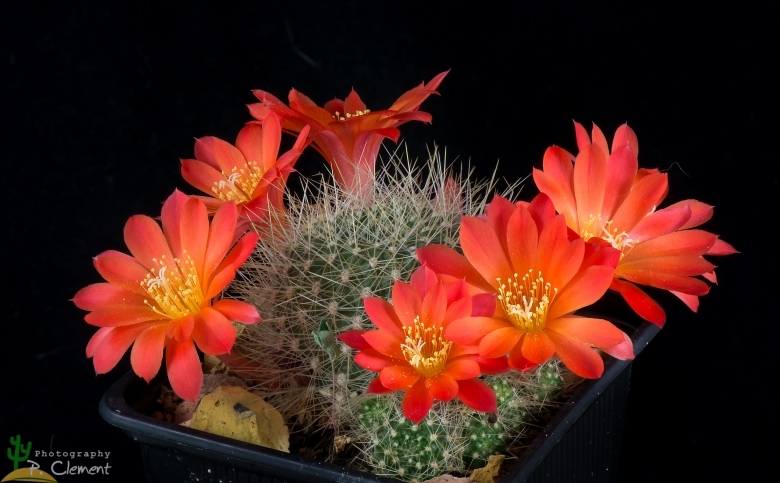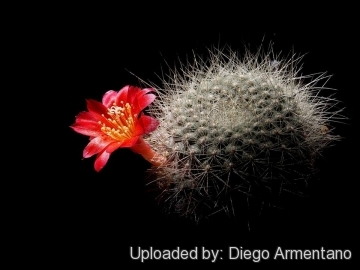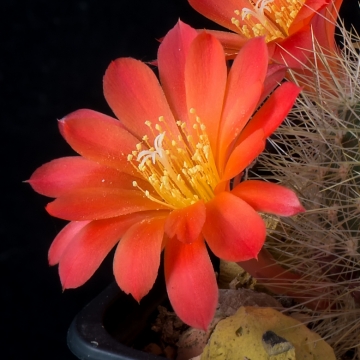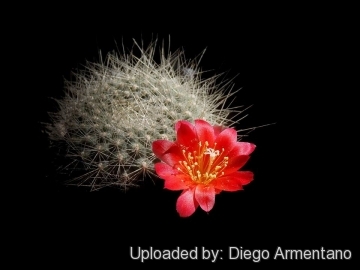
Rebutia wessneriana Photo by: Peiffer Clement
Origin and Habitat: Jujuy, Northern Argentina.
Altitude range:1600-2400 metres above sea level.
Synonyms:
See all synonyms of Rebutia wessneriana
back
Accepted name in llifle Database:Rebutia wessneriana Bewer.Kakteenkunde 2: 24, fig. 1948Synonymy: 26
back
Description: Rebutia wessnerianaSN|15448]]SN|15448]] is a tiny freely clustering cactus, branching at ground level to form low dense groups or mounds up to 15 cm wide. Rebutia wessnerianaSN|15391]]SN|15448]] is a good species regarded separately from Rebutia krainzianaSN|895]]SN|895]], with which it has sometimes been linked, and the numerous subspecific names are regarded as synonymous, but some authors consider this species as one of the morphological form of the widespread and variable Rebutia minusculaSN|15448]]SN|15391]], distinguished by long white bristles and large, blood-red flowers with yellowish throats. Rebutia wessnerianaSN|15448]]SN|15448]] is a highly variable taxon, which reacts strongly to environmental conditions, in particular the size and number of spines is greatly influenced by the level of light, at lower light levels the spines are less numerous, delicate and white, while with strong solar radiation the spines are stronger with a brownish tint. In some cases differences are referable to separate population. Many such variants have been described as species in the past.
Derivation of specific name: This member of the Cactaceae family was given this name in honor of the German merchant and owner of a cactus nursery Wilhelm Wessner (1904-1983). Wessner's rebutia.
Stems: Depressed globose, bright green or reddish-green in strong sunlight, lacking spines apically, to 7 cm high and 8 cm in diameter, with fibrous roots.
Ribs: Spiraling, not always completely divided into tubercles, tubercles up to 2 mm, hexagonal when present.
Areoles: Elliptical, white 5 mm long, 5 mm apart.
Spines: About 25, about 20 mm long, hardly distinguishable as radial and central, stiff, bristle-like, interlacing molstly white, uppermost ones sometimes with brownish tip.
Flowers: Heterogamous, borne on sides of stems, bright scarlet to bloodred with yellowish throats, to 5.5 cm in diameter. Pericarpel and floral tube red with violet red scales. Perianth segments narrowly lanceolate, long-pointed, about 30 mm long and 6 mm wide. Filaments reddish, anthers pale yellow. Pistil pink-orange, basally fused for 2-3 mm with the narrow flower tube.
Fruits: Globose, 5-7 mm in diameter, pale violet to dull reddish violet, with purple scales.
Seeds: Oblong, over 1 mm long; testa glossy black; hilum basal yellowish white.
Bibliography: Major references and further lectures
1) Edward Anderson “The Cactus family” Timber Press, Incorporated, 2001
2) John Pilbeam “Rebutia” Cirio Pub. Services, 01 May 1997
3) Walther Haage “Cacti as House Plants” Studio Vista, 1965
4) Eggli, Urs; Newton, Leonard E. “Etymological Dictionary of Succulent Plant Names”. Springer. 2004
5) Backeberg, Curt; “Die Cactaceae”, 3: 1551, 1959
6) Backeberg, Curt; “Das Kakteenlexikon”, p. 384, 385, 1966
7) Bewerunge, W.; “Kakteen und andere Sukkulenten”, 24: 181, 1973
8) Donald, John Donald; Nat. Cact. Succ., 14: 4, 1959
9) Hlinecký, Antonín; “Rod Rebutia K. Schumann”; Fričiana, 5/36: 18, 1965
10) Köhler, Udo; Kakteen und andere Sukkulenten, 15: 134, 1964
11) Krainz, Hans; “Die Kakteen”, 14: CVc, 1960
12) Simon, Wilhelm; Kakteen und andere Sukkulenten, 22: 238, 1971
13) Šída, Otakar; “Atlas kaktusů”, tab. 52, 1990
14) Šída, Otakar; “Rod Rebutia”, p. 41, 1997
15) Wikipedie: Otevřená encyklopedie: Rebutia wessneriana [online]. c2016 [citováno 17. 04. 2016]. Dostupný z WWW: <https://cs.wikipedia.org/w/index.php?title=Rebutia_wessneriana&oldid=13333552>
 Rebutia wessneriana Photo by: Diego Armentano
Rebutia wessneriana Photo by: Diego Armentano Rebutia wessneriana Photo by: Peiffer Clement
Rebutia wessneriana Photo by: Peiffer Clement Rebutia wessneriana Photo by: Diego Armentano
Rebutia wessneriana Photo by: Diego ArmentanoSend a photo of this plant.The gallery now contains thousands of pictures, however it is possible to do even more. We are, of course, seeking photos of species not yet shown in the gallery but not only that, we are also looking for better pictures than those already present.
Read More... Cultivation and Propagation: Rebutia wessnerianaSN|15448]]SN|15448]] is a summer grower species that is easy to cultivate.
Growth rate: It is a relatively rapidly growing and easily flowering species that will make clumps given the best conditions.
Soils: It likes very porous standard cactus mix soil. Prefer a neutral or low pH compost, avoid substrata rich in limestone.
Repotting: It is better that they are repotted regularly. Repotting will increase the number and size of stems and will increase the number of flowers produced. Repot yearly until reaching about 100 mm in size, then every two or three years will suffice. Repotting is best done at the end of winter but can be done at other times. Do not water for a couple of weeks after repotting to reduce risk of root rot via broken roots. Use pot with good drainage.
Watering: Needs moderate to copious waterings in summer, but do not overwater (Rot prone), keep dry in winter at a minimum temperature of 0°C.
Fertilization: Feed with a high potassium fertilizer in summer.
Hardiness: Reputedly resistant to frost if kept on the dry side prior to, and during, cold weather (hardy to -4 C ° C, or less for short periods).
Exposition: The plant tolerates bright situations but enjoys filtered sunlight or afternoon shade, inside it needs bright light, and some direct sun. Tends to bronze in strong light, which encourages flowering and heavy spine production, but is likely to suffer from sun scorch or stunted growth if over exposed to direct sunlight during the hottest part of the day in summer.
Uses: It is an excellent plant for container growing. It always looks good and stays small. It look fine in a cold greenhouse and frame or outdoor in a rockery.
Pests & diseases: It may be attractive to a variety of insects, but plants in good condition should be nearly pest-free, particularly if they are grown in a mineral potting-mix, with good exposure and ventilation. Nonetheless, there are several pests to watch for:
- Red spiders: Red spiders may be effectively rubbed up by watering the plants from above.
- Mealy bugs: Mealy bugs occasionally develop aerial into the new growth among the wool with disfiguring results, but the worst types develop underground on the roots and are invisible except by their effects.
- Scales: Scales are rarely a problem.
- Rot: This species is particularly easy and accommodating, seldom suffer of cryptogamic diseases. Rot it is only a minor problem with rebutias if the plants are watered and “aired” correctly. If they are not, fungicides won't help all that much.
Propagation: Division, direct sow after last frost. Seeds germinate in 7-14 days at 21-27° C in spring, remove gradually the glass cover as soon the plants will be well rooted (ca 1-2 weeks) and keep ventilated, no full sun for young plants! Seed Collecting: Permit fruit to ripen. Fruit must be significantly overripe before harvesting seed; clean and dry seeds. To make a cutting twist off a branch and permit it to dry out a couple of weeks, lay it on the soil and insert the stem end partially into the soil. Try to keep the cutting somewhat upright so that the roots are able to grow downward.













